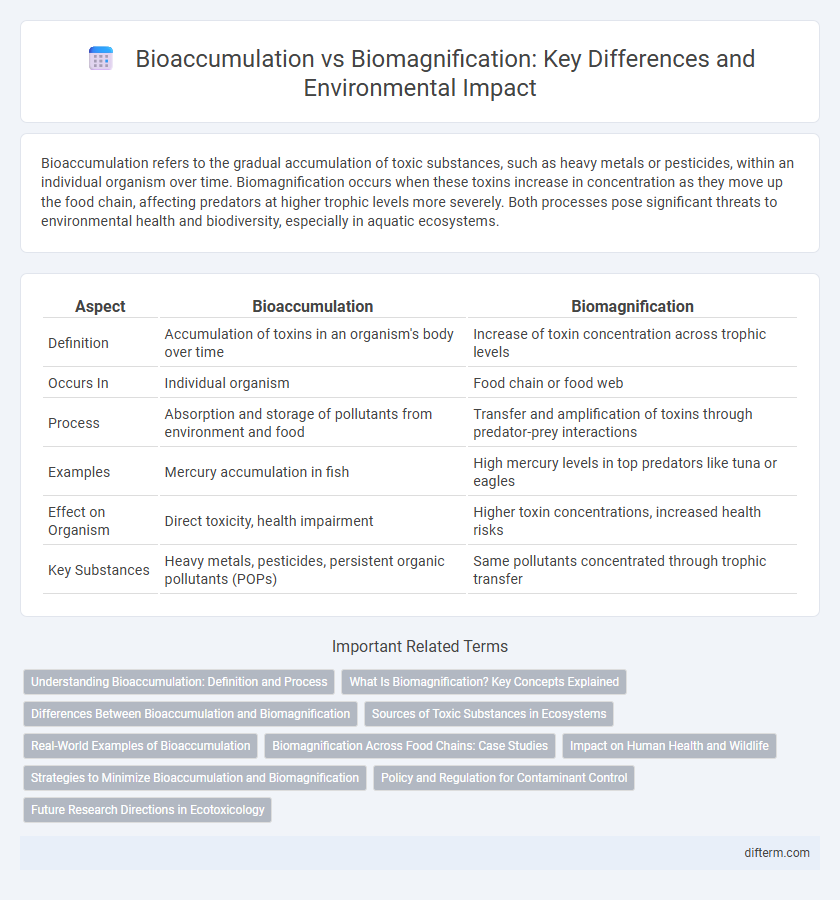Bioaccumulation refers to the gradual accumulation of toxic substances, such as heavy metals or pesticides, within an individual organism over time. Biomagnification occurs when these toxins increase in concentration as they move up the food chain, affecting predators at higher trophic levels more severely. Both processes pose significant threats to environmental health and biodiversity, especially in aquatic ecosystems.
Table of Comparison
| Aspect | Bioaccumulation | Biomagnification |
|---|---|---|
| Definition | Accumulation of toxins in an organism's body over time | Increase of toxin concentration across trophic levels |
| Occurs In | Individual organism | Food chain or food web |
| Process | Absorption and storage of pollutants from environment and food | Transfer and amplification of toxins through predator-prey interactions |
| Examples | Mercury accumulation in fish | High mercury levels in top predators like tuna or eagles |
| Effect on Organism | Direct toxicity, health impairment | Higher toxin concentrations, increased health risks |
| Key Substances | Heavy metals, pesticides, persistent organic pollutants (POPs) | Same pollutants concentrated through trophic transfer |
Understanding Bioaccumulation: Definition and Process
Bioaccumulation refers to the gradual accumulation of toxins, such as heavy metals or persistent organic pollutants, in an organism's tissues over time through direct exposure or consumption of contaminated food. This process occurs when the rate of toxin intake exceeds the organism's ability to eliminate them, leading to higher concentrations in its body compared to the surrounding environment. Understanding bioaccumulation is crucial for assessing the impact of environmental pollutants on wildlife health and ecosystem stability.
What Is Biomagnification? Key Concepts Explained
Biomagnification is the progressive increase in the concentration of toxic substances like mercury or DDT as they move up the food chain from prey to predator. Unlike bioaccumulation, which occurs within a single organism over time, biomagnification results in higher toxin levels at each successive trophic level, posing significant risks to apex consumers such as birds of prey and humans. This ecological process highlights the importance of monitoring persistent organic pollutants and heavy metals that persist in ecosystems and threaten biodiversity and human health.
Differences Between Bioaccumulation and Biomagnification
Bioaccumulation refers to the gradual buildup of toxins in an individual organism's tissues over time, while biomagnification describes the increasing concentration of these toxins as they move up the food chain. Bioaccumulation occurs at the organism level, whereas biomagnification impacts entire ecosystems by amplifying toxin levels in predator species. The primary difference lies in bioaccumulation being a single-organism process and biomagnification being a population-level phenomenon affecting trophic levels.
Sources of Toxic Substances in Ecosystems
Toxic substances enter ecosystems primarily through industrial discharge, agricultural runoff, and atmospheric deposition, contributing to both bioaccumulation and biomagnification. Persistent organic pollutants (POPs), heavy metals like mercury and lead, and pesticides are common contaminants that accumulate in organisms and magnify along food chains. These toxins originate from sources such as mining activities, fossil fuel combustion, plastic waste, and improper chemical disposal, intensifying ecological and health risks.
Real-World Examples of Bioaccumulation
Mercury bioaccumulation in fish such as tuna and swordfish poses significant health risks to humans and wildlife due to prolonged exposure in aquatic environments. Persistent organic pollutants like DDT accumulate in the fatty tissues of predatory birds, leading to eggshell thinning and population declines. Industrial chemicals such as PCBs bioaccumulate in marine mammals like seals and dolphins, causing immune system suppression and reproductive issues.
Biomagnification Across Food Chains: Case Studies
Biomagnification refers to the increasing concentration of toxins, such as mercury and DDT, as they move up the food chain, affecting apex predators like eagles and orcas. Case studies in aquatic ecosystems highlight how mercury levels in small fish accumulate in larger predatory fish, culminating in critical toxicity in top-level species. This process contrasts with bioaccumulation, which occurs within a single organism over time, emphasizing the amplified risk of contaminants through trophic transfer in biomagnification.
Impact on Human Health and Wildlife
Bioaccumulation refers to the gradual accumulation of toxic substances, such as heavy metals or persistent organic pollutants, within an organism's tissues, posing significant health risks including neurological damage and reproductive issues. Biomagnification amplifies these toxins through the food chain, resulting in higher concentrations in top predators like birds of prey, marine mammals, and humans, which can lead to severe immune system impairment and developmental disorders. Both processes disrupt ecosystems and biodiversity, highlighting the critical need for monitoring and mitigating pollutant emissions to protect both human health and wildlife.
Strategies to Minimize Bioaccumulation and Biomagnification
Implementing phytoremediation using plants like sunflowers and willows effectively extracts heavy metals from contaminated soils, reducing bioaccumulation in local ecosystems. Enhancing wastewater treatment processes to remove persistent organic pollutants diminishes the introduction of toxins that biomagnify through aquatic food webs. Promoting sustainable agricultural practices that limit pesticide and chemical fertilizer use further curtails the accumulation of harmful substances in organisms, protecting biodiversity and human health.
Policy and Regulation for Contaminant Control
Effective policy and regulation for contaminant control must address both bioaccumulation and biomagnification to mitigate ecological and human health risks. Regulatory frameworks should enforce limits on persistent organic pollutants (POPs) and heavy metals that bioaccumulate in organisms and magnify through food chains, such as mercury and PCBs. Implementing stringent monitoring programs and contaminant discharge standards ensures reductions in pollutant levels, protecting aquatic ecosystems and communities reliant on fisheries.
Future Research Directions in Ecotoxicology
Future research in ecotoxicology should prioritize understanding molecular mechanisms underlying bioaccumulation and biomagnification to predict contaminant behavior in diverse ecosystems. Advances in omics technologies and environmental monitoring can enhance detection of sub-lethal effects on aquatic and terrestrial organisms. Integrating ecological modeling with big data analytics will improve risk assessment and mitigation strategies for persistent organic pollutants and heavy metals.
bioaccumulation vs biomagnification Infographic

 difterm.com
difterm.com